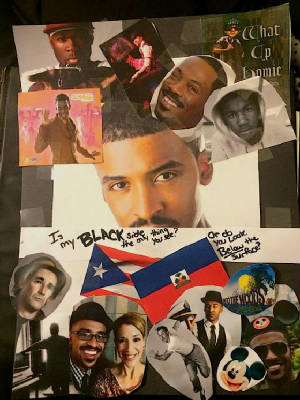|
|
Some Family Portrait Collages made after
studying Jacob
Lawrence themes in his "MIgration" Series at MoMA, Spring 2015
Portrait of
My Mom, by Exie Robertson" My mother, Diana, is depicted here in the style of Jacob
Lawrence's "The Migration Series", 1941. I chose to focus my final collage on my mother, who happens to be going
through many changes in her life for a woman as established as she is. My mother lost her job last September as a result of
agism. She is extremely qualified and was underpaid in her field, and her employer decided to let her go and hire someone younger, who would take the job for less financial compensation. My
mother had been going on interviews and having phone calls daily to figure out what her next move will be in her career. She
had a closet full of interview suits and spends her days researching prospective institutions and companies she'd like to
work for, also reaching out to every contact she has made. When you're a woman over fifty, it seems like finding a job can
be a full time job in itself. I placed my mom in a classic black suit and a smart bag because it seems to be her uniform these
days. She is standing over a background of dreamy blue water and beach, cut out from an old issue of Travel and Leisure magazine.
When mom isn't working to find a job, she is dreaming of our next island getaway when we can just relax and forget a while.
The words speak for themselves and relate to what my mother is and what her experience has been in her professional life and
in her job search. "Up to 50" "one-of-a-kind" "classic" and "knowing", all relate
to my extremely intelligent, fascinating, talented mother, and where her future will bring her. 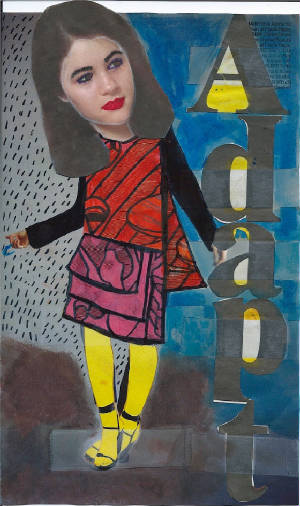 Olivia Transcending and Adapting, in the style of "The Migration", 1941, by Jacob Lawrence, by Sienna D'Addario I decided to create a portrait of my younger
sister, Olivia. She is one of my very best friends, and she is going through an amazing time in her life. Over the past few
years my sister has been transcending from girl to woman. This transition is specifically important for my sister because
she is often treated like a little girl. Olivia is on the autistic spectrum, and because of this, she is often treated as
much younger than she actually is. Olivia will be turning eighteen this year, so her transition is becoming vitally important,
and necessary. In essence, she is in migration from how the world views her to how she actually deserves to be viewed. I cannot
imagine what it must be like to feel and look like a woman, but to be treated like a little girl. Immense frustration at times,
and peace at others; however, in this collage I wanted to show her as a full-blown woman. She is decked out with a mod style,
triangular dress, in bright color blocked patterns. Her face is done up with red lips, and purple eye lashes to show not only
traditional glamour, but also to show her colorful personality. My inspiration for color and layout came from one specific
portrait of Jacob Lawrence’s “The Migration” series. In particular, his fifty-eighth portrait labeled “In
the North the Negro had better educational facilities”. While viewing this portrait I was struck by its colors, and
shapes. There are three young girls depicted in this portrait. Each young girl is wearing a different color dress of the same
shape, and they are all in the process of writing numbers on a chalkboard. My goal was to capture the same background coloring
that Lawrence created, as well as bolder colors in the front ground. I was also set on using the same style of dress that
appears on each little girl, a sort of triangular dress that a child might draw on a female stick figure. In Lawrence’s
portrait of Northern migration, the young girls in the classroom have their backs turned to us, and similarly I wanted to
convey the sense of voyeurism in my portrait. Olivia is depicted looking off into the distance, perhaps wondering what will
come next along her unique journey into womanhood.
Untitled (a self-stereotype portrait)
by Paul A. Richards "Creating Your
Own Stereotype"? Life isn't just black and white. My collage attempts to exemplify how we create our own stereotypes
and fight the ones people place on us. I've listed all the qualities I want on the right and all the negative ones on the
left. Social media allows for us to craft who we want to be rather than just allow people to project onto us. In my portrait
I am half in color and half in black and white. I'm split between those things I fear to be and those things I want to
be. I use my social media to craft a stereotype of myself as the strong and confident New York actor who left home to pursue
his dream. We create these stereotypes to escape the black and white negative stereotypes. My life is a battle between who
I want to be and who I don't.
|
||||||
|
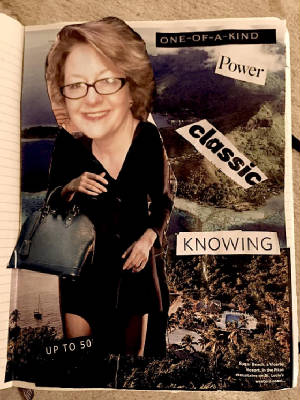
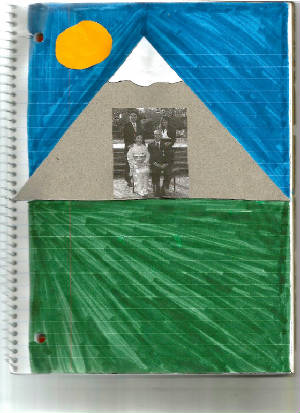 My Family "Yamaguchi" by
Kelli Yamaguchi
My Family "Yamaguchi" by
Kelli Yamaguchi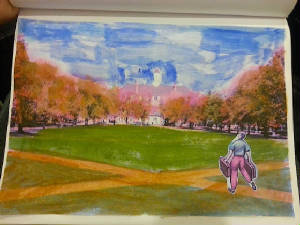 Portrait of my father, a.k.a. panel #21, The Migration Series, 1941 by Jacob
Lawrence by Alex Lee
Portrait of my father, a.k.a. panel #21, The Migration Series, 1941 by Jacob
Lawrence by Alex Lee 